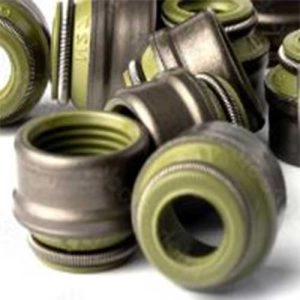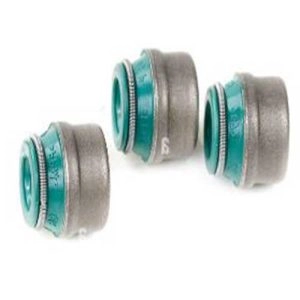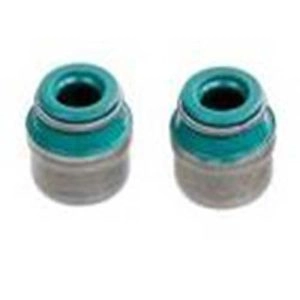Valve seals are one of the most important parts of the engine. They contribute to controlling the engine oil consumption, lubricating the air and fire valves. The way they are designed and manufactured is crucial to ensure the best performance and service life of the engine.
The main function of the valve seals is to prevent the mixture of oil with the fuel and air mixture inside the combustion chamber of the engine, so as not to contaminate the mixture. In addition, it prevents the gases resulting from combustion from polluting the oil located in the engine parts and the cylinder head.
Generally, the engine valve seals are made from various materials, such as nylon, steel, and rubber. They are sometimes manufactured in complex, highly durable ways by integrating these materials into one design. Then, they are fitted into a small collar at the top of the valve stem.
On the other hand, damaged engine valve seals can result in the engine's oil burning and emitting blue smoke, in addition to contaminating the spark plugs with carbon deposits. These issues can negatively impact the engine's lifespan. Therefore, it is necessary to promptly replace the engine's valve seals when required.
Finally, engine valve seals may generally appear similar, but they are not truly identical. Original and well-manufactured seals can withstand temperatures up to 225 degrees Celsius, while poor-quality seals fail to withstand temperatures higher than 120 degrees Celsius.
In this article, we will discuss the valve seals, explain the most prominent signs indicating their damage, and clarify the difference between them and the rocker arms, so stay with us.
Also read:4 Symptoms Indicating Damage to a Car's Scissors Jack
What are the signs of engine valve seal damage?

Here are the most common signs of engine valve seal damage:
1- Blue or gray emissions coming out of the exhaust pipe:
This is one of the most prominent and common signs of damaged valve seals. When you start the car engine in the morning, you will see a lot of blue and gray smoke coming out of the exhaust. This happens because there is a quantity of oil on the upper part of the cylinder head, this oil was previously pumped during the engine operation.
On the other hand, if the car is left for a long time without being started, the valve seals cool down, which causes them to shrink and form a small gap. When you start the engine in this condition, the remaining oil is sucked from the shrunken valve seals into the combustion chamber, which results in the appearance of blue and gray smoke. Likewise, leaving the car idle for a long time leads to blue emissions from the exhaust every time the car accelerates.
2- Carbon buildup on the spark plug head:
The accumulation of carbon on the spark plug electrodes indicates contamination. This happens when heavy oil-based carbon deposits gather on top of the air valves, often due to wear and tear. As carbon deposits accumulate, the pressure may increase until it reaches the stage where it can cause engine damage.
3- Engine oil deficiency:
If you notice a decrease in engine oil, this could indicate damage to the valve seals and oil leakage or substantial burning, resulting in a larger-than-usual reduction in its quantity and proportion. You can tell that the engine oil is diminishing by checking the engine oil gauge.
How does the engine valve seal get damaged?

Here are some common reasons that may lead to damage of the engine's valve seals:
Valve seals typically operate for distances up to approximately 240,000 km under normal driving conditions, but they wear out and get damaged over time.
Failure to regularly change the engine oil may lead to early damage to the engine.
Improper installation by the maintenance center can quickly lead to damage to the leather shortly after installation.
The difference between valve seals and valve guides.

There are several differences between the valves and valve seals, which anyone interested in knowing everything about cars must understand. We will try to clarify and explain them in a simplified manner.
Engine Valve Seal: Located around the air and fire valves, it protects the oil and fuel mixture from oil contamination, as well as protects the cylinders from the entry of burnt gases.
The valve seals: These are several rings surrounding the pistons. Their function is to regulate oil pressure and adjust the amount consumed by the car engine.
You can distinguish between them by diagnosing the faults you notice in your car, for example:
Blue smoke emission from the exhaust pipe:Blue, very dense smoke appears continuously when the spark plugs are damaged, while it's the opposite when the engine valve seals are damaged, where the smoke appears when starting the car and disappears after a while.
Engine Oil Shortage:Damaged bearings require the addition of more oil frequently, while damage to the engine valve seals does not cause this.
Decline in acceleration and loss of torque:Damage to the crankshaft leads to a loss of engine power due to a drop in pressure inside the combustion chamber, but this does not occur when the valve seals are damaged.
Engine pressure drop:This is the most prominent sign to distinguish between damageValve SealsAnd damage to the spark plugs.

Comments